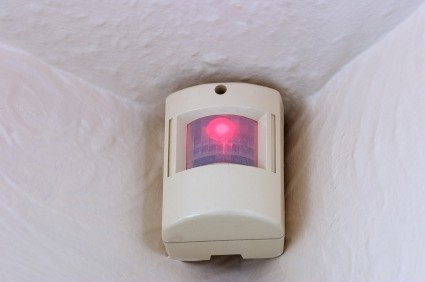
Be secure if you’re working from home
Motion sensors use single or multiple units to detect movement in certain areas; together, the sensors should cover most of the floor space in the home or office. Once a sensor is tripped, a signal is sent to the central control panel of your security system, either sounding an alarm or alerting either yourself or the necessary authorities to the potential threat.
Let’s look at the technology behind them.
The Part Motion Sensors Play in Home Security
The main purpose of a motion sensor is to detect an intruder. You set your motion detectors to start monitoring whenever you leave your home, or create zones that are empty at certain times. The latter is a useful option if you have pets and want to let them wander in some rooms at night-time.
Motion sensors can trigger instantly, and can be set and positioned so to react quickly to potential intruders by indicating whether a door or window has been opened or broken. You can also use motion sensors to mark certain areas as ‘off limits’.
Types of Motion Sensor Alarms
There are two main types of motion sensors: active and passive.
- Passive sensors do not emit energy themselves, but read changes in energy levels in the areas they are monitoring.
- Active sensors do emit energy, typically in the form of infrared light, microwave radiation or sound waves.
Passive infrared (IR) sensors are the most commonly used motion sensor alarms in home security systems. An IR sensor detects heat and movement in the area it is monitoring; the sensor alarm is tripped if the energy levels change rapidly, indicating unexpected movement from a human body.
A microwave motion sensor sends out microwaves that are used to measure the distance between the sensor and objects within the room it is monitoring. If sudden changes in these distances are detected, or a new object is measured with rapid changes in the distance from it to the sensor, the motion sensor alarm is tripped and the alarm is sounded.
There are other kinds of motion sensors, such as IR reflection, ultrasonic and vibration technologies. Some motion sensor alarms combine two or more separate technologies, increasing their effectiveness.
Positioning Motion Sensor Alarms
Typically, intruders enter premises through the same points of entry you use: doors and windows. However, they will access them through unusual methods. A flat roof or drainpipe could be an invitation to test a window and crawl inside.
Angel Security recommends that you have a motion sensor alarm in every room where a point of entry exists – including upstairs rooms. Your sensor should be positioned in such a way that means they are parallel to the point of entry, rather than pointing straight towards it. And naturally, all sensors should be serviced regularly.
Keep Yourself and Your Loved Ones Safe
Motion sensors are highly effective. They detect unwanted intrusion almost immediately, tripping alarms and alerting both yourself and (optionally) a third party. Speak to Angel Security about getting your motion sensors serviced, and make sure your home is adequately protected by these ingenious little devices.












